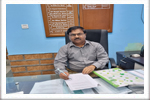Dhupguri Municipality was established in 2002 and had
a population of 44,719: 22,953 men (51%) and 21,766 women (49%).
Dhupguri has a literacy rate of 78%, higher than the national average of
74.04%; male literacy is 81.61% and female literacy 74.21 %. In Dhupguri, 9.64 percent of the population is under age six.
The
government-regulated wholesale market, locally known as Dhupguri Hut, was
established for wholesaling agricultural products and is West Bengal's
second-largest market. In addition to agriculture, small-scale industries are
also growing.
A
Rajbongshi community surrounds Dhupguri; Rajbongshi means "royal
community". They have a rich cultural heritage and language. The Koch
Rajbongshi people called themselves "Kamateshwars" (rulers of
Kamata), but their influence and expansion were so extensive that their kingdom
is sometimes called the Koch Kingdom.
Bhawaiya song is a popular musical form
in North Bengal, particularly in the Cooch Behar and Jalpaiguri districts.
The
Last Darvesi Singer Sri Kalachand Darvesh and renowned poet Punyaslok Dasgupta
were belonging from this place.
Dhupguri's
college (co-ed) Sukanta Mahavidyalaya, was founded in 1981.
Dhupguri
Girl's College, established in 2013.
Dhupguri
High School, the town's oldest school, opened in 1945.
The Dhupguri
railway station provides connections to all parts of the country through
passenger-train service. Many long-distance trains (including superfast trains)
like (Kanchenjunga Express, Kamrup Express, Aronai Express, uttarbanga Express,
etc.) pass through Dhupguri daily and provide links to other parts of India.
The town is also connected by road to much of West Bengal.
The nearest major
railway station to Dhupguri is New Jalpaiguri (NJP) which is at a distance of
80 kilometres.
The nearest Airport is at Bagdogra which is at distance of 90 Kilometres.


